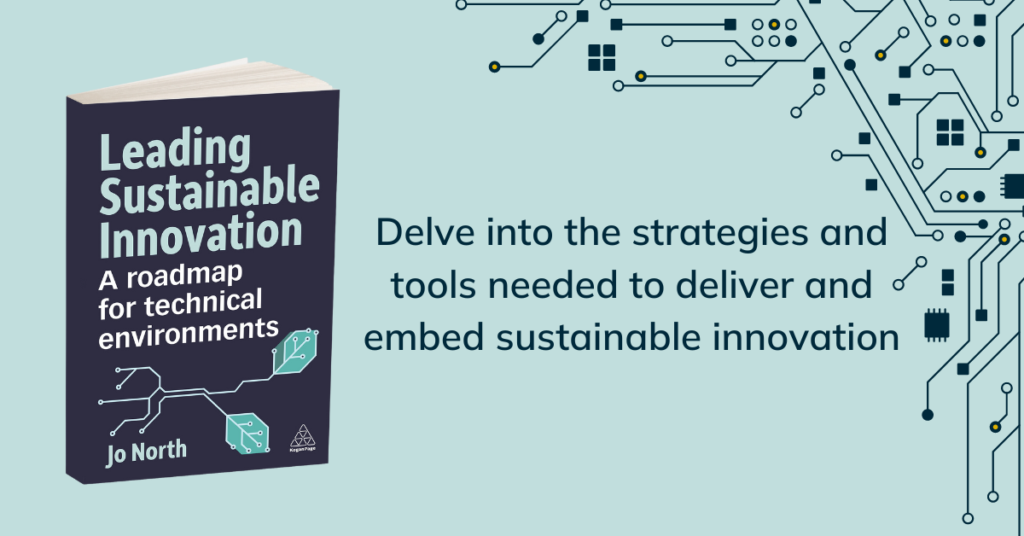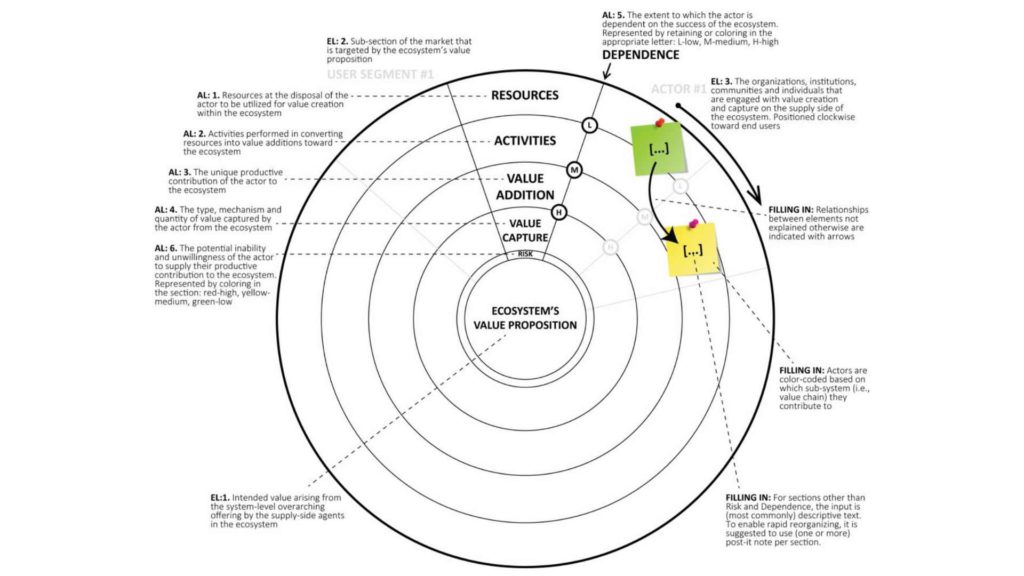Posted in Blog, Innovation, Lead by Jo North
What is an innovation ecosystem?
What is an innovation ecosystem? James F. Moore, is a researcher and author known for his work on business ecosystems. In his seminal 1996 work, Moore introduced the concept of business ecosystems as “an economic community supported by a foundation of interacting organizations — the organisms of the business world.”
My definition of an innovation ecosystem today is an organic system in which businesses large and small, including start-ups, public sector organizations, academia and the not-for-profit, media and culture sectors work together to shape new, purposeful solutions to significant, shared challenges and opportunities.
These partners from across the private sector, the public sector, research institutions and civil society are known as the “quadruple or quintuple helix” – quintuple when the ecosystem includes stakeholders representing the natural environment.
Every organization in an innovation ecosystem depends on the success of the other organizations, either directly or indirectly.
Innovation ecosystems can be large or small, co-located physically or virtually. The participating organizations have multiple direct and indirect links between them. Ideas, knowledge, connections, finance and people resources cycle between participants, as successful organizations reinvest back into the ecosystem.
All business is a series of connected ecosystems. However, innovation ecosystems often have their own identities, stated purpose and carry out activities that are targeted to achieve business innovation.
Innovation ecosystems can either have a formal structure, including governance regime, or be created and managed through more informal affiliation.
If you’d like a more in-depth look at innovation ecosystems, with a detailed guide to how to develop and get the most from them for all participants, my book, Leading Sustainable Innovation: a roadmap for technical environments, available from all good booksellers worldwide, has specific content that will help you.

Drivers of innovation ecosystems
At the heart of each thriving innovation ecosystem is a clear, relevant shared purpose.
Innovation ecosystems often exist to solve shared challenges – such as economic growth, eco-innovation and decarbonization, skills or materials shortages.
They also form to exploit shared innovation strategy and opportunities, such as the formation of a supply chain for a major manufacturer or sector. An example of this is the North East Automotive Alliance (NEAA), an industry-led automotive cluster, established to support the economic sustainable growth and competitiveness of the automotive sector in the North East of England.
Innovation ecosystem map
Because each innovation ecosystem is unique, comprising multiple participants with complex relationships, it is often useful to create an ‘innovation ecosystem map’.
The innovation ecosystem map is a visual representation of all the stakeholders directly and indirectly involved, showing their relative importance, connections and relationships with each other.
The map also contains the innovation ecosystem’s value proposition, how collaborative innovation is intended to add collective value to particants’ success, the activities that will take to achieve them, the resources needed and potential risks and associated management actions.
An example of an innovation ecosystem map is the Ecosystem Pie Model tool (Talmar et al, 2020), shown below.
For other examples, you can find a recent innovation ecosystem map for Australia here, and one for the Map of Start-ups for the Italian Rainforest here.
You might also want to take a look at my step-by-step guide to stakeholder mapping here.
What is an open innovation ecosystem?
Open innovation is an approach taken by a business, organisation or network to access the ideas, technology and knowledge that is available externally, beyond its employees and existing supply chain.
An open innovation ecosystem develops when participants in innovation ecosystems expand their organizational resources and seek new ideas, knowledge and solutions from external collaborators. This promotes the flow, clustering, and bringing together of resources within an innovation ecosystem for creative leadership.
Why are innovation ecosystems important?
Innovation ecosystems are important because, when they work well, they can bring multiple benefits:
- The voice and influence of the participants acting together is greater than that of one or a few of them
- Greater competitiveness, sector and / or place awareness, also leading to better economic, social and environmental outcomes (e.g through job creation and increased prosperity, green growth)
- Improved effectiveness and efficiency, through combined activities and shared resources
- More and stronger interpersonal networks
- Greater shared and individual creativity, knowledge and skills development
The power of innovation ecosystems
Technological advancements, including artificial intelligence and electric vehicles, are key elements of sustained growth. They enable your innovative ideas to evolve into new business models and successful innovations. For instance, Arizona State University and Stanford University have been pivotal in nurturing innovation communities that prioritize higher education, research, and systematic approaches to problem-solving.
Government institutions often offer tax incentives and programs such as Innovate UK to help you drive growth. These initiatives bring together ecosystem players, external partners, and local leaders to support innovative solutions. Collaborative efforts between different actors ensure ongoing innovation and adaptation to market changes.
Social innovation
Your innovation ecosystem can thrive with a culture of continuous improvement and the sharing of best practices. By understanding the natural ecosystem’s interdependence, your local innovation ecosystem can address particular needs and create a competitive advantage for your entire community, developing social innovation ecosystems that tackle societal challenges through collective effort.
For example, in 2024, the Regenerative Community Tokyo initiative showed how developing a culture of continuous improvement and sharing best practices can enhance local innovation ecosystems. Launched in Tokyo’s Marunouchi neighborhood, this community brings together corporations focused on addressing complex urban challenges through collaborative efforts. By leveraging the interdependence of various stakeholders, the initiative tailors solutions to specific community needs, creating a competitive advantage and supporting social innovation to tackle societal challenges together.
Small business benefits
Y Combinator is a great example of how early-stage companies can benefit from innovation hubs and external collaboration for start ups, helping small businesses to turn their innovative ideas into larger corporations or impactful solutions. By leveraging various sources of funding and support, they are able to achieve bigger things.
Innovation ecosystem policy
Because innovation ecosystems can generate significant benefits, some government organizations around the world actively support and promote their development.
Examples of Innovation Ecosystem Policy from around the World
USA
Building a thriving innovation ecosystem requires the collective effort of various actors. Small businesses, government institutions, academic institutions, and private companies each play a crucial role. The U.S. Small Business Administration emphasizes the importance of small businesses in fostering innovation and driving economic impact. According to the SBA’s Office of Advocacy, small businesses generate 44% of U.S. economic activity and create two-thirds of net new jobs, demonstrating their vital contribution to the economy.
Additionally, the SBA’s Small Business Innovation Research (SBIR) program stimulates technological innovation by investing federal research and development funds into innovative high-tech small businesses.
Israel
Israel is considered an exemplar by several other countries for its successful innovation ecosystem. An article on Forbes (2021) describes Israel’s accomplishments as follows:
“Israel has long been known as the “Startup Nation” with more than 6,000 active startups, making it the world leader for startups per capita. Recently, with the increase in unicorns (Israel has the highest number of unicorns per capita) as well as R&D centers of multinational corporations (530 R&D centers), Israel is transforming to become the “Scale-Up Nation.”
Forbes Business Council
A Deloitte report concurs:
“Israel’s unique society and culture, strong economy, government support, and “global-first” market approach are just a few of the factors that make Israel’s innovation ecosystem one of the most successful in the world.
The Israeli Technological Eco-system, Deloitte
European Union (EU)
The EU states that it “aims to create more connected and efficient innovation ecosystems to support the scaling of companies, encourage innovation and stimulate cooperation among national, regional and local innovation actors”.
United Kingdom
The UK Innovation Strategy states that the UK aims to learn “from the pandemic to create the world’s best innovation ecosystem”.
Australia
Australia’s National Innovation and Science Agenda includes innovation ecosystem principles as one of its top priorities: “Working together: increasing collaboration between industry and researchers to find solutions to real world problems and to create jobs and growth.”
New Zealand
New Zealand has a thriving innovation ecosystem that encourages world-leading research and development (R&D) activity and resourceful ways of making innovation happen, especially through its dedicated agency, Callaghan Innovation.
Callaghan Innovation New Zealand
Callaghan Innovation is New Zealand’s government agency dedicated to supporting innovation in New Zealand.
Callaghan Innovation’s team of more than 200 of New Zealand’s leading scientists and engineers – empower innovators by connecting people, opportunities and networks, and providing tailored technical solutions, skills and capability development programmes, and grants co-funding.
Their role is also enhance the operation of New Zealand’s innovation ecosystem, working closely with government partners, Crown Research Institutes, and other organisations that help increase business investment in R&D and innovation.
They have created Scale Up NZ, which they describe as “a free platform you can use to navigate New Zealand’s business and innovation ecosystem…to find and connect with collaborators and investors, track recent deals and investments, search for key players by sector or business stage, and explore up-to-date market data.”
Singapore
The Singapore government takes what it describes as a “sandbox approach” to innovation ecosystem development. This enables innovators, universities and companies to work together to innovate and test new products and ideas for the region and beyond.
Local and regional innovation ecosystems
Many of the national government policies for innovation are delivered in practise by local and regional innovation ecosytems, centered on a specific industry sector, business stage (usually start-up or scale-up) and / or location.
Local government, universities and businesses participate in these innovation ecosystems.
For example, the Federal Economic Development Agency for Southern Ontario is using national government funding for regional innovation ecosystems to achieve these advantages, listed on its website here:
- Grow and sustain strategic clusters and consortia that support businesses to scale up and commercialize innovative products, technologies and services.
- Enhance the development and reach of business incubators, accelerators, and other organizations, which support entrepreneurs, start-ups and innovative companies with high-growth potential.
- Support projects led by innovation-oriented organizations to increase and promote business productivity and global competiveness, and investment and talent attraction.
- Leverage local advantages, institutions and infrastructure in rural areas.
What sort of participants should an innovation ecosystem include?
A thriving, inclusive innovation ecosystem needs to include a wide diversity of participants, from businesses at all stages, and all sizes, academia, government, not-for-profits, research organizations, funders and skills providers.
Diversity matters because it creates greater richness of expertise, ideas, network connections and perspectives.
It is also important to include keystone organizations (Iansiti and Levien, 2004), also known as platform leaders (Cusumano and Gawer, 2002; 2014) or ecosystem leaders (Moore, 1993), in the ecosystem. These are the most significant members, acting as the anchor that ensures growth and stability in the ecosystem.
What are some of the challenges of operating in an innovation ecosystem?
Whilst there are substantial benefits of operating in an innovation ecosystem, there are also challenges:
- Participating businesses need to recognize when it is best to collaborate, and when they will need to compete.
- How much time, resource and money should be invested, by whom and for whose benefit.
- How to satisfy the trade-off organizations will need to make at times between doing what’s best for their own position versus what is in the interests of the greater good.
- Considerations around knowledge exchange and intellectual property protection.
- Governance and gaining consensus amongst participants on strategic and tactical decision-making.
- Practical considerations, such as finding times and locations when participants can be available to meet.
- Management of historic and ongoing rivalries and local organizational politics.
What makes a strong innovation ecosystem?
Thriving innovation ecosystems in locations such as New York, London, Tel Aviv, Singapore and Tokyo, indicate that the success factors are:
- Strong accessible funding to accelerate high-potential innovations getting off the ground, such as the one in Israel. Both government and investor funding are available, especially for digital innovation.
- The right mix of diverse ecosystem partners.
- Culture of collaboration, such as that cultivated by Level 39 in London, to optimize ecosystem-wide ideation, knowledge exchange, co-operation and decision-making.
- Collective knowledge exchange platform, for example Silicon Valley, an established innovation ecosystem that has prioritized protecting the intellectual property assets of its innovators.
- Innovation talent
- Research and development (R&D) capability
- Agility and responsiveness to external events, to pivot and innovate at speed in a fast-changing world.
Governance and management
The role of the keystone organization is critical to the successful management of the innovation ecosystem. It needs to:
- Facilitate the creation of a vision and value proposition.
- Influence other potentially key players.
- Make space and shape processes to cultivate innovation across the entire ecosystem.
- Nurture mutually beneficial relationships between all types of participants.
- Ensure that the innovation ecosystem adapts and evolves in line with external changes, to best support its members.
Examples of innovation ecosystems
1. Maritime 2050 Innovation Hub at Port of Tyne, UK
The UK’s first 2050 Maritime Innovation Hub is a partnership with Port of Tyne, Drax, Offshore Renewable Energy Catapult (OREC), Nissan, Connected Places Catapult, Accenture, Royal HaskoningDHV, Ubisoft and the Department for Transport.
The 2050 Maritime Innovation Hub inspires partners to collaborate to develop solutions to technological challenges facing the maritime sector and the wider logistics industry both nationally and globally. It acts as a catalyst for sharing ideas, harnessing research and development, advancing technology and tackling shared challenges.
Fully aligned with the Government’s Maritime 2050 Strategy, the Maritime 2050 Innovation Hub works closely with the Department for Transport and MarRI-UK to ensure that it delivers for the benefit of the maritime sector as a whole.
2. Catapults
The Catapult Network comprises independent, not-for-profit private organisations transforming the UK’s capability for innovation in sectors of strength. Established by Innovate UK, the Catapult Network brings together nine leading technology and innovation centres – called Catapults – spanning over 40 locations across the UK. A Catapult is where the application of research is accelerated, where new technologies are further developed, scaled up and realized.
3. Level 39 London, UK
Level 39 is an innovation ecosystem of 1,250 leaders in cybersecurity, fintech, retail tech and smart cities. It is based in Canary Wharf, London. Members are based on site, or join virtually as ecosystem partners.
How to build an innovation ecosystem
To build an innovation ecosystem, start with these steps:
- Create a clear purpose, vision and value proposition, being mindful that it is likely to evolve as more partners come on board. You’ll need to have some early ideas to hand, though, before you speak to potential partners.
- Map out the first stage visually, including everyone you need on board in the early stages. Don’t include too many or too few people too soon, though. Make it manageable, with enough people to gain early traction.
- Speak to the members you think you must have on board from the outset to gain their buy-in and commitment.
- Arrange your first session. This can be an innovation sprint or workshop to collaborate on how you’re going to proceed to create a successful, thriving innovation ecosystem.
Set-up and facilitation expertise
By focusing on clear goals, systematic approaches, and a strong innovation mindset, you can help your community adapt to industry trends and societal needs. Innovation ecosystems are crucial for turning your ideas into reality and ensuring sustained growth for all ecosystem players.
Here at the Big Bang Partnership, we are highly skilled and very experienced when it comes to starting, growing and facilitating innovation ecosystems.
Whether your innovation ecosystem is an early idea, or whether it’s well established and could benefit from some fresh thinking and new energy, we are ready, excited and very able to help you. Do get in touch with us here for a complimentary chat. We’re looking forward to hearing from you!



